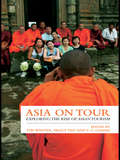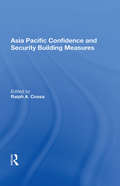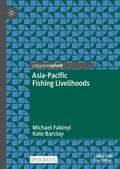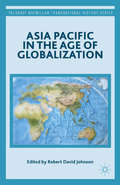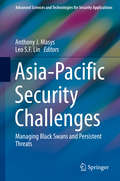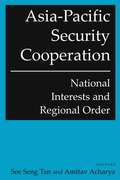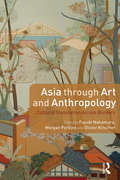- Table View
- List View
Asia on Tour: Exploring the rise of Asian tourism
by Tim Winter Peggy Teo T. C. ChangWith the vast majority of academic theory on tourism based onWestern tourists, Asia on Tour illustrates why the rapid growth of travel for leisure and recreation in Asia demands a reappraisal of how tourism is analyzed and understood. Examining domestic and intra-regional tourism, the book reveals how improvements in infrastructures, ever increa
Asia Pacific Confidence And Security Building Measures
by Ralph A. CossaThis book provides a summation of many of the key points and insights that emerged during the first meeting of the Council for Security Cooperation in the Asia Pacific Confidence and Security Building Measures Working Group in Washington, D.C., in October 1994.
Asia Pacific Confidence And Security Building Measures
by Ralph A. CossaThis book provides a summation of many of the key points and insights that emerged during the first meeting of the Council for Security Cooperation in the Asia Pacific Confidence and Security Building Measures Working Group in Washington, D.C., in October 1994.
Asia Pacific Economic Cooperation: Challenges and Tasks for the Twenty First Century (PAFTAD (Pacific Trade and Development Conference Series))
by Ippei YamazawaThis book provides the most up-to-date and comprehensive account of the APEC (Asia Pacific Economic Cooperation) organisation and examines the challenges APEC now faces in the new century. Subjects covered include:* the history of APEC* APEC and the latest WTO round* case-studies of countries in the region including China, Japan, Malaysia, Korea and Taiwan* APECs approach to competition and deregulation policy* assessment of APECs standing as an international institutionFeaturing contributions from distinguished groups of international academic experts, this book is essential reading for all those interested in political and economic developments in the Asia-Pacific.
Asia Pacific Economic Cooperation: Challenges and Tasks for the Twenty First Century (PAFTAD (Pacific Trade and Development Conference Series))
by Ippei YamazawaThis book provides the most up-to-date and comprehensive account of the APEC (Asia Pacific Economic Cooperation) organisation and examines the challenges APEC now faces in the new century. Subjects covered include:* the history of APEC* APEC and the latest WTO round* case-studies of countries in the region including China, Japan, Malaysia, Korea and Taiwan* APECs approach to competition and deregulation policy* assessment of APECs standing as an international institutionFeaturing contributions from distinguished groups of international academic experts, this book is essential reading for all those interested in political and economic developments in the Asia-Pacific.
Asia-Pacific Economic Cooperation (APEC): The First Decade
by Werner Draguhn Eva Manske Jürgen RülandThe Asia-Pacific Economic Cooperation (APEC) was founded in 1989. Since then the forum has developed into a major player in tri-partite relations between North America, East Asia and Europe. The Seattle and Bogor Summits were landmark events suggesting to many observers a gravitational shift in the world economy and world politics. Yet the Asian financial crisis had a sobering effect on high-flying expectations as APEC contributed little to crisis management. In the light of such contradictory performance, distinguished scholars here examine APEC's achievements and failures, its role and functions in international relations, its linkages with regional organisations and the interplay between the forum and national interests of major factors in the region.
Asia-Pacific Economic Cooperation (APEC): The First Decade
by Jürgen Rüland Eva Manske Werner DraguhnThe Asia-Pacific Economic Cooperation (APEC) was founded in 1989. Since then the forum has developed into a major player in tri-partite relations between North America, East Asia and Europe. The Seattle and Bogor Summits were landmark events suggesting to many observers a gravitational shift in the world economy and world politics. Yet the Asian financial crisis had a sobering effect on high-flying expectations as APEC contributed little to crisis management. In the light of such contradictory performance, distinguished scholars here examine APEC's achievements and failures, its role and functions in international relations, its linkages with regional organisations and the interplay between the forum and national interests of major factors in the region.
Asia-Pacific Financial Deregulation (PAFTAD (Pacific Trade and Development Conference Series))
by Gordon De Brouwer Wisarn PupphavesaRecent events in East Asia have highlighted the risks of volatility and contagion in a financially integrated world. Countries in the region had been at the forefront of the movement towards increased integration but the crisis that struck Thailand in July 1997, and the rapidity with which it spread to other East Asian nations, suggested that all was not well. Weaknesses in domestic financial intermediation, poor corporate governance and deficient government responses to large capital inflows all played a role in the build-up of vulnerability. Asia-Pacific Financial Deregulation provides an insight into financial liberalisation and structural reform in the region generally and as illustrated by a number of countries.
Asia-Pacific Financial Deregulation (PAFTAD (Pacific Trade and Development Conference Series) #5)
by Gordon De Brouwer Wisarn PupphavesaRecent events in East Asia have highlighted the risks of volatility and contagion in a financially integrated world. Countries in the region had been at the forefront of the movement towards increased integration but the crisis that struck Thailand in July 1997, and the rapidity with which it spread to other East Asian nations, suggested that all was not well. Weaknesses in domestic financial intermediation, poor corporate governance and deficient government responses to large capital inflows all played a role in the build-up of vulnerability. Asia-Pacific Financial Deregulation provides an insight into financial liberalisation and structural reform in the region generally and as illustrated by a number of countries.
Asia-Pacific Fishing Livelihoods
by Michael Fabinyi Kate BarclayThis open access book explores fishing livelihoods in the context of the wider contexts in which they are embedded. Drawing on case studies from across the Asia-Pacific region, the book highlights how fishing livelihoods are shaped by globalisation, social relationships and governance. The book concludes by showing how better understanding these relationships can contribute to governance for healthier ecosystems and social wellbeing.This is an open access book.This is an open access book.
Asia Pacific in the Age of Globalization (Palgrave Macmillan Transnational History Series)
by Robert David JohnsonThe essays in this volume examine United States-East Asian relations in the framework of global history, incorporating fresh insights that have been offered by scholars on such topics as globalization, human rights, historical memory, and trans-cultural relations.
Asia-Pacific in the New World Order
by Christopher Brook Anthony McGrewAsia-Pacific in the New World Order critically explores the notion that a distinctive regional power bloc is developing linking countries bordering the Pacific, with East Asia at its core. This student-friendly volume sheds light on the complex interplay between global, regional and national forces which have transformed the Asia-Pacific area into one of the most vibrant and economically successful regions in the world. Historical narratives alongside geopolitical and geoeconomic perspectives are deployed to examine the shifting pattern of power relations and security structures across the region, set within a wider world context.Key issues addressed include:* what are the primary security problems of the region and how are they being resolved?* does the dynamic growth of the region, and particularly the rise of China, pose a challenge to existing structures of world order?The text has a strong interdisciplinary flavour drawing on analytical approaches from the international relations, political economy and political geography literature. Authors have been drawn from the Asia-Pacific region and the UK and all are established scholars in their specialist fields.
Asia-Pacific in the New World Order
by Christopher Brook Anthony McGrewAsia-Pacific in the New World Order critically explores the notion that a distinctive regional power bloc is developing linking countries bordering the Pacific, with East Asia at its core. This student-friendly volume sheds light on the complex interplay between global, regional and national forces which have transformed the Asia-Pacific area into one of the most vibrant and economically successful regions in the world. Historical narratives alongside geopolitical and geoeconomic perspectives are deployed to examine the shifting pattern of power relations and security structures across the region, set within a wider world context.Key issues addressed include:* what are the primary security problems of the region and how are they being resolved?* does the dynamic growth of the region, and particularly the rise of China, pose a challenge to existing structures of world order?The text has a strong interdisciplinary flavour drawing on analytical approaches from the international relations, political economy and political geography literature. Authors have been drawn from the Asia-Pacific region and the UK and all are established scholars in their specialist fields.
Asia-Pacific Nations in International Peace Support and Stability Operations (Asia Today)
by Chiyuki Aoi Yee-Kuang HengThis book aims to provide for a path-breaking cross-regional comparison of the capabilities and readiness of Asia-Pacific countries to contribute to peace support missions, with an eye to identifying emerging trends and policy implications.
Asia-Pacific Security Challenges: Managing Black Swans and Persistent Threats (Advanced Sciences and Technologies for Security Applications)
by Anthony J. Masys Leo S.F. LinThis edited book examines the contemporary regional security concerns in the Asia-Pacific recognizing the ‘Butterfly effect’, the concept that small causes can have large effects: ‘the flap of a butterfly’s wings can cause a typhoon halfway around the world’. For many Asia-Pacific states, domestic security challenges are at least as important as external security considerations. Recent events (both natural disasters and man-made disasters) have pointed to the inherent physical, economic, social and political vulnerabilities that exist in the region. Both black swan events and persistent threats to security characterize the challenges within the Asia-Pacific region. Transnational security challenges such as global climate change, environmental degradation, pandemics, energy security, supply chain security, resource scarcity, terrorism and organized crime are shaping the security landscape regionally and globally. The significance of emerging transnational security challenges in the Asia-Pacific Region impact globally and conversely, security developments in those other regions affect the Asia-Pacific region.
Asia-Pacific Security Cooperation: National Interests and Regional Order
by See Seng TanNew developments in the Asia Pacific are forcing regional officials to rethink the way they manage security issues. The contributors to this work explore why some forms of security cooperation and institutionalisation in the region have proven more feasible than others.
Asia-Pacific Security Cooperation: National Interests and Regional Order (Belfer Center Studies In International Security Ser.)
by See Seng TanNew developments in the Asia Pacific are forcing regional officials to rethink the way they manage security issues. The contributors to this work explore why some forms of security cooperation and institutionalisation in the region have proven more feasible than others.
The Asia Pacific War: Impact, Legacy, and Reconciliation (Routledge Studies in the Modern History of Asia)
by Yasuko ClaremontThis book examines key aspects of the Asia Pacific War (1931–1945), that was initially waged between Japan and China, before Japan’s attack on Pearl Harbor drew in the U.S.-led allied forces from 1941 to 1945. Part I of the book examines three interlocking components, the origins of the war; its impact on combatants and civilians; and its short-term legacy, including the huge changes that took place in the postwar governance of Japan. Part II explores the ongoing impact and legacy of the war for those in postwar Japan, and later generations, particularly through the examination of the ambiguity of state-led reconciliation with Japan’s neighbors, the growth of dynamic civil reconciliation efforts, and the prominent role of the arts in peace movements. Through a people-centered approach it filters historical events through the lens of the war’s impact on individuals, who found themselves players within a larger frame of the social history of Japan and caught up in the international power dynamics of the nuclear age. Featuring studies of contemporary peace activism, this will be a valuable resource to students and scholars of Modern Asian and U.S. History, as well as those interested in postwar memory and reconciliation.
The Asia Pacific War: Impact, Legacy, and Reconciliation (Routledge Studies in the Modern History of Asia)
by Yasuko ClaremontThis book examines key aspects of the Asia Pacific War (1931–1945), that was initially waged between Japan and China, before Japan’s attack on Pearl Harbor drew in the U.S.-led allied forces from 1941 to 1945. Part I of the book examines three interlocking components, the origins of the war; its impact on combatants and civilians; and its short-term legacy, including the huge changes that took place in the postwar governance of Japan. Part II explores the ongoing impact and legacy of the war for those in postwar Japan, and later generations, particularly through the examination of the ambiguity of state-led reconciliation with Japan’s neighbors, the growth of dynamic civil reconciliation efforts, and the prominent role of the arts in peace movements. Through a people-centered approach it filters historical events through the lens of the war’s impact on individuals, who found themselves players within a larger frame of the social history of Japan and caught up in the international power dynamics of the nuclear age. Featuring studies of contemporary peace activism, this will be a valuable resource to students and scholars of Modern Asian and U.S. History, as well as those interested in postwar memory and reconciliation.
Asia Struggles with Democracy: Evidence from Indonesia, Korea and Thailand (Routledge Contemporary Asia Series)
by Giovanna Maria DoreSince 1974, when the current wave of democratisation began, the movement towards democracy in Asia has remained limited. Many countries in Asia, in fact, are not making a decisive move towards democracy, and find themselves struggling with the challenges of democratic consolidation and governance. Focusing on Indonesia, Thailand and Korea, this book analyses why democratisation is so difficult in Asia. The book investigates the dynamics by which citizens embrace democratic rule and reject authoritarianism, and also compares these dynamics with those of consolidating democracies around the world. The book looks at the forces that affect the emergence and stability of democracy, such as elite interactions, economic development and popular attitudes as beliefs and perceptions about the legitimacy of political systems have long been recognised as some of the most critical influences on regime change. The book also discusses what it is about the nature of public opinion and the processes of day-to-day democratic participation that have made these countries vulnerable to repeated crises of legitimacy. Using Indonesia, Korea, and Thailand as case studies, this book highlights the uniqueness of the Asia’s path to democracy, and shows both the challenges and opportunities in getting there. The book will be of interest to students and scholars of Asian Politics, Comparative Politics and International Studies.
Asia Struggles with Democracy: Evidence from Indonesia, Korea and Thailand (Routledge Contemporary Asia Series)
by Giovanna Maria DoreSince 1974, when the current wave of democratisation began, the movement towards democracy in Asia has remained limited. Many countries in Asia, in fact, are not making a decisive move towards democracy, and find themselves struggling with the challenges of democratic consolidation and governance. Focusing on Indonesia, Thailand and Korea, this book analyses why democratisation is so difficult in Asia. The book investigates the dynamics by which citizens embrace democratic rule and reject authoritarianism, and also compares these dynamics with those of consolidating democracies around the world. The book looks at the forces that affect the emergence and stability of democracy, such as elite interactions, economic development and popular attitudes as beliefs and perceptions about the legitimacy of political systems have long been recognised as some of the most critical influences on regime change. The book also discusses what it is about the nature of public opinion and the processes of day-to-day democratic participation that have made these countries vulnerable to repeated crises of legitimacy. Using Indonesia, Korea, and Thailand as case studies, this book highlights the uniqueness of the Asia’s path to democracy, and shows both the challenges and opportunities in getting there. The book will be of interest to students and scholars of Asian Politics, Comparative Politics and International Studies.
Asia, the US and Extended Nuclear Deterrence: Atomic Umbrellas in the Twenty-First Century
by Andrew O'NeilSince the end of the Cold War, significant attention has focussed on the issue of nuclear deterrence and in particular whether formal nuclear security guarantees from nuclear weapons states to non-nuclear weapons states involving the possible use of nuclear weapons have a place in the twenty-first century global strategic landscape. Growing support for nuclear disarmament in the US and elsewhere has seen serious doubts being raised about the ongoing utility of extended nuclear deterrence. This book provides the first detailed analysis of the way in which extended nuclear deterrence operates in contemporary Asia. It addresses the following key questions: What does the role of extended nuclear deterrence in Asia tell us about the broader role of extended nuclear deterrence in the contemporary international system? Is this role likely to change significantly in the years ahead? O’Neil uses a theoretical and historical framework to analyse the contemporary and future dynamics of extended nuclear deterrence in Asia and challenges many of the existing orthodox perspectives on the topic. Providing a new perspective on debates surrounding extended nuclear deterrence, this book will be of interest not only to students and scholars of Asian politics, international relations and security studies, but also to policy makers and professionals.
Asia, the US and Extended Nuclear Deterrence: Atomic Umbrellas in the Twenty-First Century
by Andrew O'NeilSince the end of the Cold War, significant attention has focussed on the issue of nuclear deterrence and in particular whether formal nuclear security guarantees from nuclear weapons states to non-nuclear weapons states involving the possible use of nuclear weapons have a place in the twenty-first century global strategic landscape. Growing support for nuclear disarmament in the US and elsewhere has seen serious doubts being raised about the ongoing utility of extended nuclear deterrence. This book provides the first detailed analysis of the way in which extended nuclear deterrence operates in contemporary Asia. It addresses the following key questions: What does the role of extended nuclear deterrence in Asia tell us about the broader role of extended nuclear deterrence in the contemporary international system? Is this role likely to change significantly in the years ahead? O’Neil uses a theoretical and historical framework to analyse the contemporary and future dynamics of extended nuclear deterrence in Asia and challenges many of the existing orthodox perspectives on the topic. Providing a new perspective on debates surrounding extended nuclear deterrence, this book will be of interest not only to students and scholars of Asian politics, international relations and security studies, but also to policy makers and professionals.
Asia through Art and Anthropology: Cultural Translation Across Borders
by Fuyubi Nakamura Morgan Perkins Olivier Krischer* AWARDED BEST ANTHOLOGY BY THE ART ASSOCIATION OF AUSTRALIA AND NEW ZEALAND *How has Asia been imagined, represented and transferred both literally and visually across linguistic, geopolitical and cultural boundaries? This book explores the shifting roles of those who produce, critique and translate creative forms and practices, for which distinctions of geography, ethnicity, tradition and modernity have become fluid. Drawing on accounts of modern and contemporary art, film, literature, fashion and performance, it challenges established assumptions of the cultural products of Asia.Special attention is given to the role of cultural translators or 'long-distance cultural specialists' whose works bridge or traverse different worlds, with the inclusion of essays by three important artists who share personal accounts of their experiences creating and showing artworks that negotiate diverse cultural contexts.With contributions from key scholars of Asian art and culture, including art historian John Clark and anthropologist Clare Harris, alongside fresh voices in the field, Asia Through Art and Anthropology will be essential reading for students and scholars of anthropology, art history, Asian studies, visual and cultural studies.----------------------------------------------------------------------------------------------------------The publication of the color plates of works by Phaptawan Suwannakudt and Savanhdary Vongpoothorn is funded by the Australian Government.
Asia through Art and Anthropology: Cultural Translation Across Borders (Criminal Practice Ser.)
by Fuyubi Nakamura Morgan Perkins Olivier Krischer Howard Morphy* AWARDED BEST ANTHOLOGY BY THE ART ASSOCIATION OF AUSTRALIA AND NEW ZEALAND *How has Asia been imagined, represented and transferred both literally and visually across linguistic, geopolitical and cultural boundaries? This book explores the shifting roles of those who produce, critique and translate creative forms and practices, for which distinctions of geography, ethnicity, tradition and modernity have become fluid. Drawing on accounts of modern and contemporary art, film, literature, fashion and performance, it challenges established assumptions of the cultural products of Asia.Special attention is given to the role of cultural translators or 'long-distance cultural specialists' whose works bridge or traverse different worlds, with the inclusion of essays by three important artists who share personal accounts of their experiences creating and showing artworks that negotiate diverse cultural contexts.With contributions from key scholars of Asian art and culture, including art historian John Clark and anthropologist Clare Harris, alongside fresh voices in the field, Asia Through Art and Anthropology will be essential reading for students and scholars of anthropology, art history, Asian studies, visual and cultural studies.----------------------------------------------------------------------------------------------------------The publication of the color plates of works by Phaptawan Suwannakudt and Savanhdary Vongpoothorn is funded by the Australian Government.
